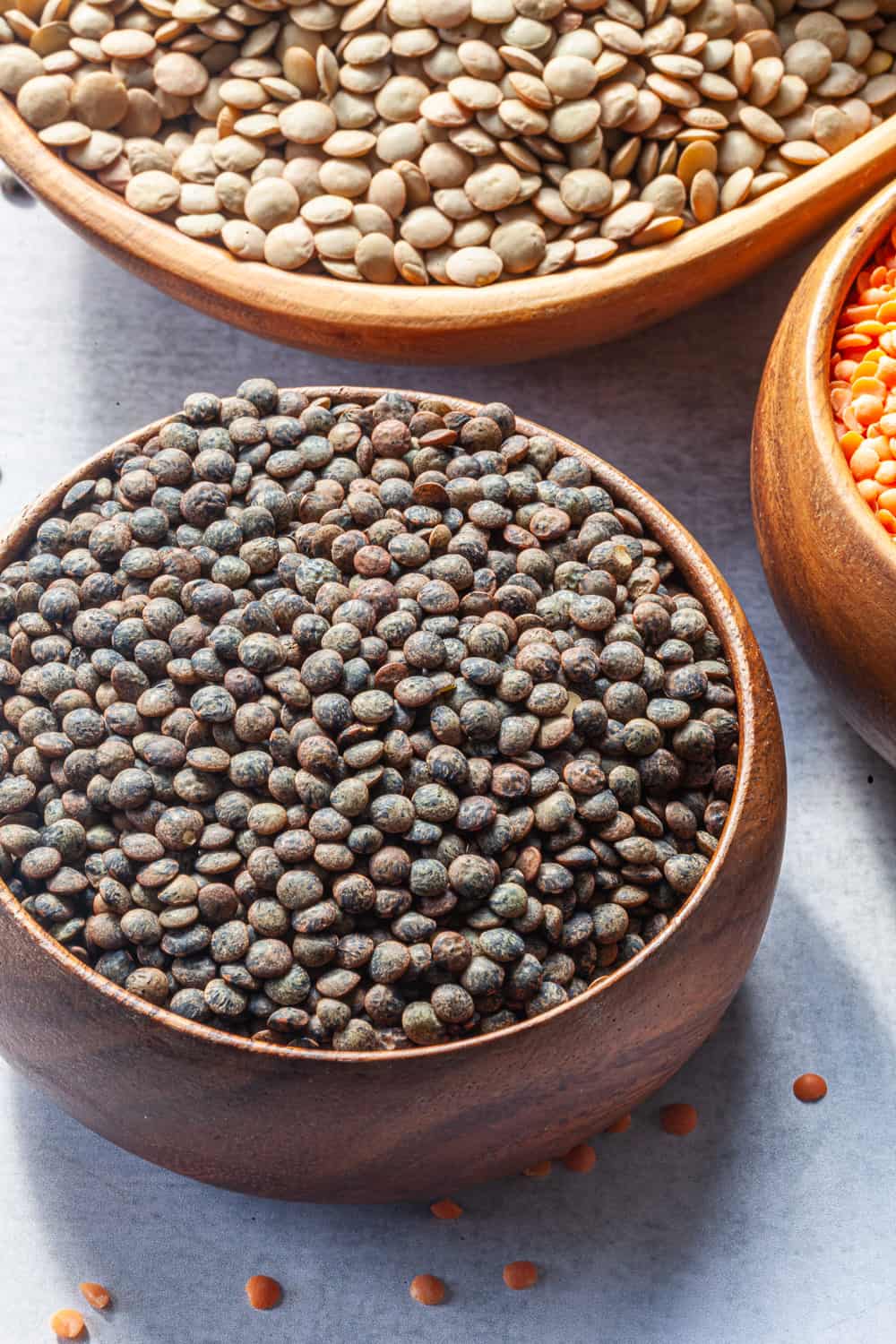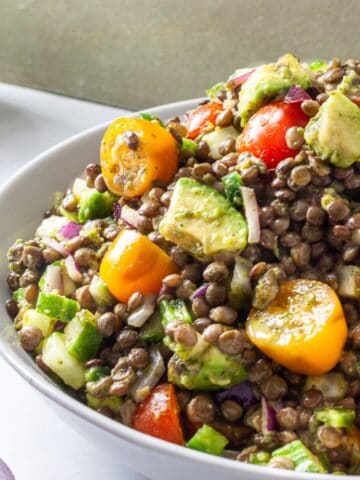Let me share my love of lentils with you!!! Learn how to cook with them, and learn about their health benefits and positive impact on the soil they grow in! These lens-shaped legumes are incredibly tasty and versatile in the kitchen!

Last year, my husband faced a health scare, ultimately leading to the removal of his gallbladder and a doctor's directive to shed some weight and adopt a healthier diet. This unexpected turn of events opened up a culinary opportunity for me. I turned to lentils and beans as fiber-rich sources of protein.
The more I experimented with lentils in my kitchen, the deeper my appreciation for them grew. Initially, I knew they were "healthy," but I had no clue of the diverse range of health benefits they offered. I've transformed into a bona fide legume enthusiast!
Lentils have since become one of my absolute favorite ingredients to work with. Not only do I take pride in serving my family nutritious meals, but I've also discovered that lentils are incredibly adaptable and delicious!
I have structured this post in order of most relevance to the average (not legum-obsessed) home cook, starting with general information about culinary applications and nutrition facts. For my fellow legum lovers, I have followed with more history and cultural context about lentils. Use this table of context to jump to the sections you are looking for:
Jump to:
What are Lentils?
Lentils are a type of legume belonging to the same family as beans and peas. They are tiny, lens-shaped seeds in various colors, including brown, green, red, and black.
Lentils have a rich history, dating back thousands of years, with origins in the Middle East and the Mediterranean region. These little powerhouses of nutrition have been a dietary staple in many cultures throughout history and continue to play a crucial role in global cuisine today. (more on the history and cultivation of lentils below.)

Types of Lentils
There are over 50 different varieties of lentils cultivated globally, each with its unique name and characteristics. In grocery stores in the United States and Canada, you'll typically encounter these most common types:
Brown and Green Lentils

When you come across brown lentils, whether sold in bulk or simply labeled as "lentils" without specifying a variety, you're likely dealing with the standard type, often called brewer lentils. On the other hand, green lentils are available in various sizes, falling into one of three classes. Larger green lentils may be Laird lentils or similar varieties, medium-sized ones are often Richlea lentils, and the smaller, classic green lentil is the Eston lentil.
The beauty of these brown and green lentil varieties is that they share similar cooking times and water-to-lentil ratios, which simplifies the cooking process. These lentils maintain their shape well during cooking, making them ideal for warm salads, casseroles, soups, and stews, and they are also an excellent choice for creating veggie burgers or vegetarian meatloaf.
Red or Yellow

Known for their creamy, buttery, and mild flavor, yellow and red lentils are preferred for those who appreciate a softer-textured legume. These lentils are unique as they are the only varieties sold in their "split" form, accelerating their cooking process due to additional refinement. The primary distinction between red and yellow lentils lies in their slight variations in nutritional content.
These somewhat sweet and nutty lentils are commonly found in Indian and Middle Eastern cuisines and play a pivotal role in classic dishes such as Indian dhal. Because of their "split" nature, this variety of lentils tends to disintegrate when cooked, making them ideal for use in soups or stews, especially as a thickening agent, and they also work well in casseroles or any dish that calls for pureed lentils.
Black or Beluga Lentils

Referred to as beluga lentils for their striking resemblance to the esteemed caviar variety, black lentils are less common than their green or brown counterparts as they thrive exclusively in cool and arid climates. These lens-shaped legumes have a robust, earthy flavor and maintain structural integrity.
Their glossy jet-black appearance adds to their unique appeal. When consumed, black lentils provide an initial hearty bite but transform into a smooth, buttery texture. Thanks to their rich, earthy flavor, velvety texture, and striking visuals, these lentils serve as an excellent foundation for salads and shine as a featured component alongside various proteins.
Puy Lentils

Puy lentils, also known as French Green Lentils, hold a special place in the world of legumes, hailing from the region of Le Puy in central France. Their unique cultivation in volcanic soil within the Regions of France sets them apart from the more common green lentils.
This distinctive growing environment imparts the lentils a flinty, earthy, and boldly peppery flavor. Puy lentils are rare compared to their counterparts, contributing to their higher price point. Unlike the traditional green lentils, Puy lentils maintain their structural integrity even after prolonged boiling, making them an excellent choice for salads.
These high-quality lentils are not meant to be mere supporting players; they can take center stage in a meal. They provide a superb foundation for meat or fish dishes and easily become the star of side dishes or main course salads.
How to cook Lentils?
There are many different ways of cooking lentils. Please check my recipe index of lentil recipes for all different kinds of cooking methods. The simplest way to cook lentils is in a large pot of water or stock. Here is my recipe for cooking lentils, which can be used in salads and great for meal prep.

Unlike quinoa or rice, you do not need an exact water-to-lentil ratio. Think more like you're cooking pasta; you need significantly more water than lentils. You can also use broth instead to add an extra layer of flavor.

I like adding a bay leaf, an onion cut in half, and a clove of garlic to add flavor to the lentils. Do not salt the lentils before cooking! They will become tough and less appetizing. Bring the water and lentils to a boil, then reduce to a simmer. Cook and low for 20-30 minutes or until tender.
The cooking time will vary slightly based on the type of lentils:
- Green Lentils: 18-20 minutes
- French Lentils: 25-30 minutes
- Brown Lentils: 20-25 minutes
- Black Lentils: 25-30 minutes
***need infographic
Drain the water (or broth) from the lentils and set them aside until they come to room temperature, before mixing into the salad. Discard the bay leaf, half onion, and garlic. Now, you can add the cooked lentils to salads or any recipe that calls for cooked lentils.

Below, you will find a complete list of recipes that incorporate lentils, and check out my full post about "how to cook lentils" for more tips and tricks on making lentils for meal prep.
The most reliable way to ascertain if lentils are fully cooked is by tasting them. Ideally, they should be tender when you bite into them. Keep in mind that different varieties of lentils may vary in texture, with some being slightly firmer and others softer. If you prefer a softer texture, simply continue to simmer them for a few extra minutes until they reach your desired consistency.
You can substitute brown and green lentils, puy lentils, and black lentils for each other in recipes. Note that puy lentils and black lentils will require more time to cook than green and brown lentils.
While you can substitute red and yellow lentils for each other, they will not be a good swap with any of the other lentils. Red and yellow lentils break down and lose their texture when cooked with a different final result.
Lower the heat to its minimum setting once you've brought the lentils to a boil. This might require using a smaller burner on your stove to prevent the lentils from vigorously simmering, as high heat and excessive movement in the pot tend to result in lentils turning mushy. Lentils can easily overcook, so monitor the cooking time closely.
Lentils and beans, although not identical, share a common family as both are classified as legumes. While lentils are not technically classified as beans, they fall under the broader category of legumes. As a group, legumes are recognized as a type of vegetable, meaning that lentils can also be considered a form of vegetable. So, lentils are indeed a type of vegetable due to their membership in the legume family.
Yes, lentils are gluten-free.
No, lentils do not align with the principles of the keto diet. Their carbohydrate content is too high for individuals following a keto regimen.
Lentil Recipes
Now it's time for the fun part!! All the recipes. The above recipes are grouped by lentil type; below, you will find recipes grouped by dish type.
Soups
Salad
Main Dishes
Sides
Are lentils good for you?
Lentils are renowned for their nutritional value and versatility in the kitchen. They are an excellent source of plant-based protein, complex carbohydrates, fiber, vitamins, and minerals.
Nutrition Facts
While different types of lentils will have slight variations of nutrition, 1 cup of cooked lentils will provide the following daily value (according to the USDA)
- 230 Calories
- 39.9 grams of Carbohydrate
- 17.9 grams of Protein
- 0.8 grams of Fat
- 15.6 grams of Fiber
- Thiamine: 28% of the DV
- Niacin: 13% of the DV
- Vitamin B6: 21% of the DV
- Folate: 90% of the DV
- Pantothenic acid: 25% of the DV
- Iron: 37% of the DV
- Magnesium: 17% of the DV
- Phosphorus: 28% of the DV
- Potassium: 16% of the DV
- Zinc: 23% of the DV
- Copper: 55% of the DV
- Manganese: 43% of the DV
They are naturally gluten-free, making them suitable for those with dietary restrictions. Their substantial dietary fiber supports digestive health and helps regulate blood sugar levels. Lentils also contain polyphenols with antioxidant properties, providing potential health advantages.
They can lower cholesterol levels, maintain healthy blood pressure, and help prevent heart disease.
For more details, check out this entire post about all the nutrition facts and health benefits of these lovely legumes!!
History and Cultivations
Lentils, scientifically known as Vicia lens or Lens culinaris, are remarkable edible legumes characterized by their distinctive lens-shaped seeds. These annual plants typically reach heights of around 40 cm (16 inches) and produce seeds in pods, often two per pod. Notably, India leads the world as the largest consumer of lentils. At the same time, Canada boasts the title of the world's largest lentil producer, with an annual global yield of approximately 6 million tons encompassing over 50 diverse varieties.
Beyond their current global prominence, lentils have an extensive history that predates modern agriculture. Archaeological findings suggest that wild lentil varieties were already being collected by humans more than 13,000 years ago. The process of lentil domestication began in the Fertile Crescent of the Near East before radiating into Europe, the Middle East, North Africa, and the Indo-Gangetic Plain. The Middle East is recognized as the primary center of diversity for both domestic Lens culinaris and its wild precursor, L. culinaris ssp. orientalis.
Lentils are more than just a nutritious addition to our diets; they also contribute to environmental sustainability. Like others in their family, these legumes host nitrogen-producing bacteria at their roots, facilitating biological nitrogen fixation and enriching the soil. As a result, lentils enhance soil quality and increase yields in subsequent cereal crops, making them a win-win choice for our health and the planet.
Pairing
These are my favorite dishes to serve with [this recipe]:

























Did you make this recipe? Let me know!